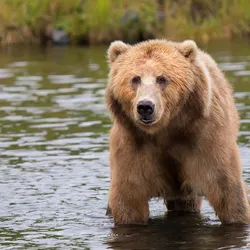
Level 1:
Bears are different kinds. Some sleep lots in winter. They eat plants and meat. Bears can talk with sounds. They protect their place. Bears are big and amazing. They have thick fat skin. They are kings of their homes. Bears live in different spots. Stories talk about bears long ago. They change to live in places. Sometimes, they come near us. We should be nice to bears. We want them to stay safe.
So, remember, bears are cool animals. They live in many homes. We can be friends with them. Keep bears safe, always.
Level 2:
Bears come in different types. Some bears sleep a lot in the winter. They eat both plants and meat. Bears make sounds to talk. They guard their homes. Bears are big and impressive. They have thick skin with lots of fat. Bears are the top animals where they live. They live in many parts of the world. Stories from the past talk about bears. They change to fit their homes. Sometimes, bears come close to where we live. We should treat them kindly. We want to keep bears safe and sound.
So, remember, bears are fascinating creatures. They live in many places. We can be friendly to them. Always work to protect bears.
Full Story:
Title: “Top Bear Facts: Discover Fascinating Insights”
Bears are amazing creatures. They roam the wild with power and majesty, but how much do we really know about them? In this article, we’re diving headfirst into the world of bears, bringing you some straightforward and no-nonsense facts that’ll leave you intrigued and informed.
Bear Species: Let’s start by understanding that there are several species of bears around the world. Grizzly bears, polar bears, black bears, and pandas are just a few examples. Each species has its unique traits and habitats, making them truly diverse members of the animal kingdom.
Hibernation: Bears are known for their ability to hibernate during the winter months. But did you know that their heart rate drops dramatically during this time, sometimes from 40-70 beats per minute to as low as 8 beats per minute? It’s like they go into a deep, energy-saving sleep mode.
Dietary Preferences: Bears are omnivores, meaning they eat both plant-based and animal-based foods. While they often feast on berries, fruits, and nuts, they’re also skilled hunters, catching fish and scavenging for carrion when the opportunity arises.
Size Matters: Bears come in various sizes, with the polar bear being the largest. Adult male polar bears can weigh up to 1,500 pounds or more! On the other hand, the smallest bear, the sun bear, averages around 60-150 pounds.
Communication: Bears may not be chatterboxes, but they do communicate with each other. They use vocalizations like roars, grunts, and woofs to express themselves, especially during mating or territorial disputes.
Amazing Sense of Smell: Bears have an extraordinary sense of smell. In fact, it’s believed that they can smell food from miles away! This incredible ability helps them locate prey or scavenge for meals.
Maternal Instincts: Mother bears are incredibly protective of their cubs. They will go to great lengths to ensure the safety and well-being of their offspring, even if it means facing danger themselves.
Human Interaction: Unfortunately, human-bear conflicts do occur. As humans encroach on bear habitats, these animals sometimes end up in populated areas in search of food. It’s essential to bear-proof your surroundings and follow guidelines for coexisting peacefully with bears.
Conservation Concerns: Many bear species are currently listed as threatened or endangered due to habitat loss and poaching. Conservation efforts are vital to ensuring the survival of these majestic animals.
Bear Myths and Legends: Throughout history, bears have been featured in myths and legends across cultures worldwide. They symbolize various qualities, from strength and courage to wisdom and protection.
Bear Adaptations: Bears have evolved unique adaptations that help them thrive in their environments. For example, polar bears have thick layers of blubber to insulate them from the cold Arctic waters, while grizzly bears have powerful claws for digging and catching prey.
Bear Biogeography: Bears are found on multiple continents, from North America to Asia. Their distribution is influenced by factors like climate, food availability, and human activities.
Bear Attacks: While bear attacks on humans are relatively rare, they can happen. It’s crucial to know how to react if you encounter a bear in the wild, such as standing your ground for some species or playing dead for others.
Bear Intelligence: Bears are intelligent animals. They can solve problems, remember locations of food caches, and adapt their behavior based on their experiences.
Role in Ecosystems: Bears play a vital role in their ecosystems as apex predators. They help control prey populations and disperse seeds through their scat, which aids in forest regeneration.
In conclusion, bears are remarkable creatures with a rich tapestry of facts and features. From their diverse species to their extraordinary adaptations, bears continue to capture our fascination. As we strive to coexist with these magnificent animals, it’s essential to respect their habitats and protect them from threats. So, the next time you hear about a bear sighting or see one in the wild, you’ll have a deeper appreciation for these awe-inspiring creatures.
Questions:
- Question: What are some of the challenges bears face in their habitats, according to the article?
Answer: According to the article, bears face several challenges in their habitats. One significant challenge is habitat loss due to human activities. As people encroach on bear habitats, it becomes more challenging for bears to find food and live safely. Additionally, bears may sometimes come into populated areas in search of food, leading to human-bear conflicts. These conflicts can be dangerous for both bears and humans. Furthermore, some bear species are currently threatened or endangered because of habitat loss and poaching. Conservation efforts are crucial to ensuring the survival of these magnificent creatures. So, in summary, bears encounter habitat loss, human-bear conflicts, and conservation issues as some of the challenges they face in their environments.
- Question: How do bears communicate with each other, and why is this important?
Answer: Bears communicate with each other through vocalizations, such as roars, grunts, and woofs. This communication is essential for various reasons. It helps bears express themselves during mating rituals and territorial disputes. For instance, a bear might roar to establish its dominance or to attract a mate during the breeding season. Additionally, communication helps bears avoid conflicts with other bears and coordinate activities like hunting or scavenging. When bears make specific sounds, they convey messages to other bears about their intentions or emotions. So, the ability to communicate through vocalizations is crucial for bears’ social interactions, ensuring they can navigate their complex relationships and environments effectively.
- Question: How do bears adapt to their environments, and why is adaptation important for their survival?
Answer: Bears adapt to their environments through various physical and behavioral changes. For example, polar bears have developed thick layers of blubber to insulate themselves from the cold Arctic waters, allowing them to swim and hunt seals effectively. Grizzly bears, on the other hand, have powerful claws for digging and catching prey, enabling them to thrive in their habitats. These adaptations are essential for their survival because they help bears find food, stay warm, and avoid predators.
- Question: What is the significance of bears in myths and legends across different cultures?
Answer: Bears hold significant cultural and symbolic importance in various myths and legends worldwide. They often symbolize different qualities, such as strength, courage, wisdom, and protection, depending on the culture and context. In many Native American cultures, bears are considered powerful spiritual beings and are featured prominently in creation stories and ceremonies. In ancient Greek mythology, the bear constellation Ursa Major is associated with the story of Callisto, a nymph turned into a bear by the goddess Artemis. These cultural connections illustrate how bears have been integral to human storytelling and belief systems throughout history, serving as symbols of various virtues and concepts.
- Question: What steps can people take to coexist peacefully with bears, and why is this important for both humans and bears?
Answer: To coexist peacefully with bears, people can take several steps. Firstly, it’s crucial to bear-proof your surroundings, securing food and trash to avoid attracting bears to populated areas. Educating yourself about bear behavior and knowing how to react if you encounter a bear in the wild is essential for safety. Additionally, supporting conservation efforts to protect bear habitats and reduce human-bear conflicts is vital. Coexisting peacefully with bears is important for both humans and bears because it ensures the safety of human communities and helps conserve bear populations. When we respect their habitats and take measures to minimize conflicts, we create a harmonious environment where bears can thrive without posing risks to human safety.
Fill in the Blanks:
Hibernation, Myths, Biogeography, omnivores, Conservation, coexist, myths, adaptations, territorial, encroach, Adaptations, Species, carrion, vocalizations, species, majestic, blubber
Bear ________: Let’s start by understanding that there are several ________ of bears around the world.
________: Bears are known for their ability to hibernate during the winter months.
Dietary Preferences: Bears are ________, meaning they eat both plant-based and animal-based foods.
While they often feast on berries, fruits, and nuts, they’re also skilled hunters, catching fish and scavenging for ________ when the opportunity arises.
They use ________ like roars, grunts, and woofs to express themselves, especially during mating or ________ disputes.
As humans ________ on bear habitats, these animals sometimes end up in populated areas in search of food.
________ Concerns: Many bear species are currently listed as threatened or endangered due to habitat loss and poaching.
Conservation efforts are vital to ensuring the survival of these ________ animals.
Bear ________ and Legends: Throughout history, bears have been featured in ________ and legends across cultures worldwide.
Bear ________: Bears have evolved unique ________ that help them thrive in their environments.
For example, polar bears have thick layers of ________ to insulate them from the cold Arctic waters, while grizzly bears have powerful claws for digging and catching prey.
Bear ________: Bears are found on multiple continents, from North America to Asia.
As we strive to ________ with these magnificent animals, it’s essential to respect their habitats and protect them from threats.
Vocabulary:
Species: A group of animals that are similar and can reproduce together.
Hibernation: A deep, long sleep that some animals go into during the winter to save energy.
Omnivores: Animals that eat both plants and meat.
Carrion: The flesh of dead animals.
Vocalizations: Sounds animals make to communicate with each other.
Territorial: Protecting an area that an animal considers its own.
Majestic: Very beautiful or impressive.
Blubber: A thick layer of fat under the skin of some animals.
Apex Predators: Animals that are at the top of the food chain and have few or no natural enemies.
Biogeography: The study of where animals and plants are found around the world.
Myths: Traditional stories that explain the beliefs or customs of a society.
Adaptations: Changes in an animal’s body or behavior that help it survive in its environment.
Encroach: To gradually take away someone else’s rights, or to gradually cover more and more of an area.
Coexist: To exist together without problems or conflict.
Conservation: The protection of animals, plants, and natural resources.




